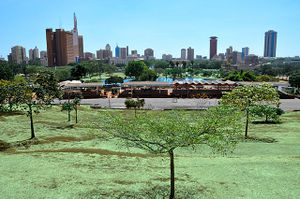Nairobi community action

The aim of this page is to recognise, celebrate and encourage the self-empowerment of community agency networks (CANs) and community groups' activism for climate, environment and many other sustainability topics across Nairobi.
 Using art to tackle air pollution: a story from a Nairobi slum, theconversation.com (Mar 04, 2019)
Using art to tackle air pollution: a story from a Nairobi slum, theconversation.com (Mar 04, 2019)
Environment quality[edit | edit source]
Open spaces[edit | edit source]
Nairobi has many parks and open spaces throughout the city. Much of the city has dense tree-cover and plenty of green spaces. The most famous park in Nairobi is Uhuru Park. The park borders the central business district and the neighbourhood Upper Hill. Uhuru (Freedom in Swahili) Park is a centre for outdoor speeches, services, and rallies. The park was to be built over by former President Daniel arap Moi, who wanted the 62-storey headquarters of his party, the Kenya African National Union, situated in the park. However, the park was saved following a campaign by Nobel Peace Prize winner Wangari Maathai.
Central Park is adjacent to Uhuru Park, and includes a memorial for Jomo Kenyatta, the first president of Kenya, and the Moi Monument, built in 1988 to commemorate the second president's first decade in power. Other notable open spaces include Jeevanjee Gardens, City Park, 7 August Memorial Park, and Nairobi Arboretum. W
Maps[edit | edit source]
The Kibera slum in Nairobi is claimed by the Kenyan government to have a population of 185,777. However, non-governmental sources generally estimate the slum to have a population of 500,000 to 1,000,000, depending on what areas are defined as comprising Kibera. W
News and comment[edit | edit source]
- "How we mapped the world's weirdest streets" by @transitapp, February 12, 2015...[1]
- When tech, dev, academia and communities work together…[2] September 29, 2011.
- A group of teenagers from Nairobi won the $8000 Passion Pictures Best Film and Artists Project Earth Youth Visions award as part of the 1 min to Save the World contest, which challenged young filmmakers to create a one-minute video about climate change.[3] Ndesanjo Macha, February 22, 2011.
References
About Nairobi[edit | edit source]
Nairobi ( ny-ROH-bee) is the capital and largest city of Kenya. The name is derived from the Maasai phrase Enkare Nairobi, which translates to 'place of cool waters', a reference to the Nairobi River which flows through the city. The city proper had a population of 4,397,073 in the 2019 census.




